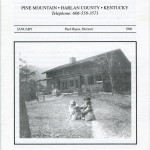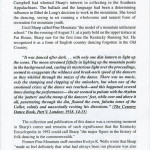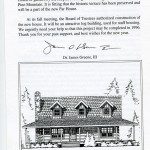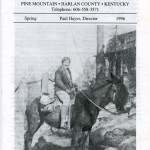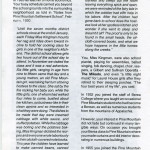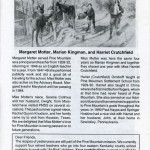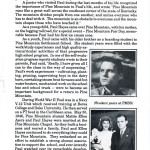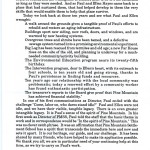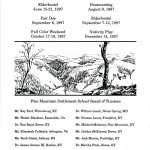Pine Mountain Settlement School
Series 17: PUBLICATIONS PMSS
Notes – 1996
Winter (January), Spring, and Fall
NOTES – 1996
“Notes from the Pine Mountain Settlement School”
Winter (January), Spring, and Fall 1996
GALLERY: NOTES – 1996 January
It is fitting that the historic terrace has been preserved and will be a part of the new Far House. – Dr. James Greene III
- NOTES – 1996 January, p. 1. [PMSS_notes_1996_jan_0011.jpg]
- NOTES – 1996 January, p. 2. [PMSS_notes_1996_jan_0021.jpg]
- NOTES – 1996 January, p. 3. [PMSS_notes_1996_jan_0031.jpg]
- NOTES – 1996 January, p. 4. [PMSS_notes_1996_jan_0041.jpg]
TAGS: NOTES – 1996 January, Far House terrace, termites, Harriet Roe, Mary Rogers, Burton Rogers, folk dancing, Cecil J. Sharp, Maud Karpeles, folksong, Katherine Pettit, Ethel de Long, Olive Dame Campbell, set running, Kentucky Encyclopedia, Evelyn K. Wells, May Day, Ballad Book
TRANSCRIPTION: NOTES – 1996 January
P. 1
PINE MOUNTAIN
SETTLEMENT SCHOOL
PINE MOUNTAIN * HARLAN COUNTY * KENTUCKY
Telephone: 606-558-3571
JANUARY Paul Hayes, Director 1996
[Cover photograph: Girl kneeling beside a dog in front of Far House I.]
FAR HOUSE AND FRIENDS
The early years, showing the
historic terrace in the background.
P. 2
Winter 1996
Dear Friend of Pine Mountain,
In this season of looking forward and looking back, Pine Mountain’s thoughts appropriately turn to Far House. Only its lovely, historic terrace remains. Irreparable termite damage to the basic support beams forced us to dismantle this historic structure, and look to its replacement in 1996.
Designed by Ethel de Long, and built in 1915, Far House anchored a third corner of the campus, in relation to Old Log and Big Log. It originally contained eight rooms and two sleeping porches, and was home to some twenty students, a housemother, and two or three additional workers. Harriet Roe, a summer worker in 1922, left this description of the house in its heyday:
“There are a number of houses for the children, but I think I drew the pick of the lot, Far House… it has two broad porches, a lovely big living-room with fireplace, nice furniture, and books and flowers. A big spinning wheel sits in the hall. The boys have a large sleeping porch, and the girls have one right over it. Each child owns a closet, and has a special place for washing. Over one of the porches grows a sweet-smelling honeysuckle. Big stepping-stones mark the path. There is a bathtub in the house, and hot water most of the time, but we have to use a Little House down the line. I must not forget to mention the variegated Persian cat, Noel. She is a great hunter, very friendly, but not affectionate, with a rattling purr. She is lying on the stone porch at this very minute scratching her chin, for I understand she has fleas. I haven’t seen any.”
After the close of the boarding school, Far House was divided into apartments and housed a succession of nurses, teachers, interns and other staff members. In its final years it was home to Mary and Burton Rogers.
In 1917, Far House was the site of an important moment in the revival of folk dance in the English-speaking world. Cecil J. Sharp, one of the truly great scholars of folksong and dance, came to Pine Mountain with his assistant, Maud Karpeles. A native of Great Britain, Sharp had discovered the treasure of folksong and dance that still existed in England, and had become both collector and promoter of the folk tradition.
Believing that folksong was the base from which the music of a nation arose, he saw in folk dances a link to the origins of a people. At Pine…
P. 3
…Mountain, as he completed the second of three summers devoted to collecting folk songs in the United States, he found kindred spirits in Katherine Pettit and Ethel de Long. Miss Pettit had early recognized the importance of ballads as cultural survivals. She had collected song texts at Hindman. She had introduced Olive Dame Campbell to ballads, and Campbell had whetted Sharp’s interest in collecting in the Southern Appalachians. The ballads and the language had been a determining influence in Ethel de Long’s decision to work in the mountains. She loved the dancing, seeing in set running a wholesome and natural form of recreation for mountain youth.
Cecil Sharp called Pine Mountain “the model of a mountain settlement school.” On the evening of August 31, at a party held on the upper terrace at Far House, Sharp saw for the first time the Kentucky Running Set. He recognized it as a form of English country dancing forgotten in the Old Country.
“It was danced after dark. . . with only one dim lantern to light up the scene. The moon streamed fitfully in lighting up the mountain peaks in the background and, casting its mysterious light over the proceedings, seemed to exaggerate the wildness and break-neck speed of the dancers as they whirled through the mazes of the dance. There was no music, only the stamping and clapping of the onlookers, but when one of the emotional crises of the dance was reached — and this happened several times during the performance — the air seemed to pulsate with the rhythm of the ‘patters’ and the tramp of the dancers’ feet, while over and above it all, penetrating through the din, floated the even, falsetto tones of the Caller, calmly and unexcitedly reciting his directions.” (The Country Dance Book, Part V. London: 1918. 14-15)
The collection and publication of this dance was a crowning moment in Sharp’s career and remains of such significance that the Kentucky Encyclopedia in 1992 could call Sharp “the major figure in the history of folk dancing in the commonwealth.”
Former Pine Mountain staff-member Evelyn K. Wells wrote that Sharp “made us feel definitely that what had always been our pleasure was also our duty, the keeping alive of these ancient things that were the children’s heritage.” A 1924 issue of the Notes summarized the vision: “Pine Mountain, Sharp said, should be the friendly soil in which all that belonged to us should be kept alive, and all the allied English songs and dances should be planted a center for English and American folklore.”
P. 4
Over the years, this vision has found expression in such things as the May Day celebration, the Ballad Book, tour groups from the school, dancing classes and parties. It still finds expression whenever a group, be it Elderhostel, a visiting elementary school class, a reunion of alumni and friends, or young people from the neighborhood takes the floor at Laurel House or gathers by the fireplace to sing. It is a living thread in the fabric of Pine Mountain. It is fitting that the historic terrace has been preserved and will be a part of the new Far House.
At its fall meeting, the Board of Trustees authorized construction of the new house. It will be an attractive log building, used for staff housing. We urgently need your help so that this project may be completed in 1996. Thank you for your past support, and best wishes for the new year.
[Signed] James Greene, III
Dr. James Greene, III
[Image: Architect’s rendering of Far House II. “This will be our new Far House”]
GALLERY: NOTES – 1996 Spring
Miss [Margaret] Motter was here the same four years as Marian Kingman and together they shared one year with Miss Harriet Crutchfield. – Paul Hayes
- NOTES – 1996 Spring, page 1. [PMSS_notes_1996_spring_0011.jpg]
- NOTES – 1996 Spring, page 2. [PMSS_notes_1996_spring_0021.jpg]
- NOTES – 1996 Spring, page 3. [PMSS_notes_1996_spring_0031.jpg]
- NOTES – 1996 Spring, page 4. [PMSS_notes_1996_spring_0041.jpg]
TAGS: NOTES – 1996 Spring, Marian Kingman, The Mikado, Margaret Motter, Harriet Crutchfield Orndorff, Advisory Board, Serene Collmus, Dwight Collmus, Rachel Quynn Knudson, Burton Rogers, Trustees, Paul Hayes, Robert Springer Hoskins
TRANSCRIPTION: NOTES – 1996 Spring
P. 1
PINE MOUNTAIN
SETTLEMENT SCHOOL
PINE MOUNTAIN * HARLAN COUNTY * KENTUCKY
Telephone: 606-558-3571
Spring Paul Hayes, Director 1996
[Photograph: Woman seated on a mule, smiling at the camera.]
P. 2
MARIAN KINGMAN — ‘Tis a lovely name because it belongs to a dear lady whom we respect and love.
Congratulations in this year of 1996 on your 96th natal day. You came to Pine Mountain Settlement School in the year of 1928 as teacher of home economics. Your busy schedule carried you beyond the school grounds into the surrounding neighborhood as told in “Notes from Pine Mountain Settlement School”, February, 1930.
“Until the seven months district schools close at the end of January, each Friday Miss Kingman mounts her nag and rides down toward incline to hold her cooking class for girls in one of the neighbor’s kitchens. The district school allows girls two hours out of the school day to attend. In November we visited the class and it was a real adventure. Six little girls, ranging in age from nine to fifteen came that day and a young matron, an old Pine Mountain girl, was taking her turn at being hostess to the class. She sat by the fire rocking her baby son, while the little girls, one of whom had walked four miles to come, bustled about her kitchen, so business-like in their clean aprons and so interested in what they were doing. The dishes to be made that day were creamed cabbage with white sauce, and stuffed potatoes. While the cabbage was boiling and the potatoes baking, Miss Kingman dictated the recipes and everyone wrote laboriously in their oilcloth-covered note books. This year the children have learned to make canned beans, canned corn, baked apples, scrambled eggs, poached eggs, candied sweet potatoes, potato soup, cinnamon buns, corn chowder, and floating island. Sitting around the oilcloth- covered table in the kitchen afterwards, eating up the class product, as is the pleasant custom, we found that not one of the six little cooks had ever before eaten creamed cabbage or stuffed potatoes. Yet there is not a family which does not possess these raw materials.
As the little girls washed and dried dishes and swept out the room leaving everything spick and span, we were reminded of the fairy tale in which the cobbler had elfin help in his labors. After the children had gone back to school does the hostess look at her spotless kitchen and wonder if she went to sleep and dreamt it all? The proof is only to be found in the small heads, the oil- cloth-covered books, and what we hope happens in the little homes along the creeks.”
You, Miss Kingman, were also school pianist, playing for assemblies, ballad singing, folk dancing, chapel, choir, vespers, a Gilbert and Sullivan Operetta – The Mikado, and even “a little night music” for Laurel House girls after they retired to their sleeping porches. “The four best years of my life”, you said.
In 1932 you joined the staff of Berea College where you taught an occasional Pine Mountain student who had become a Berean, as well as numerous students from the mountains of Appalachia.
However, your interest in Pine Mountain did not fade but continued in many tangible ways. On occasion you brought your Berea class to Pine Mountain where you made curtains and did interior decorating in numerous buildings.
In 1955 you joined the Pine Mountain Board of Trustees. You served faithfully and contributed much before retiring to Highland Farms, Black Mountain, North Carolina.
Happy Birthday and Thank You
Marian Kingman!
P. 3
Margaret Motter, Marian Kingman, and Harriet Crutchfield
[Photograph: Women and mules in a wooded setting.]
Margaret Motter served Pine Mountain as a principal and teacher from 1928-32, returning in 1946 as an English teacher for a year. From 1947-49 she performed publicity work and did a good bit of traveling for the school. Miss Motter was also active on the Advisory Board. Margaret lived in Maryland until her passing in 1984.
Miss Motter’s niece, Serene Collmus and her husband, Dwight, from Maryland have visited PMSS on several occasions. This past summer a great-niece, Rachel Quynn Knudson, and her family came by to visit from Houston, Texas. We are delighted that Miss Motter’s love for Pine Mountain is being passed on to future generations.
Miss Motter was here the same four years as Marian Kingman and together they shared one year with Miss Harriet Crutchfield.
Harriet (Crutchfield) Orndorff taught at Pine Mountain Settlement School from 1929-30. Harriet also taught in China where she first met Burton Rogers, whom at that time had never heard of Pine Mountain. She also served on our Advisory Board and has remained supportive to Pine Mountain’s goals throughout the years. In 1990 Paul Hayes and Springer Hoskins had a nice visit with Harriet and her husband, John, at their home in Sewickley, Pennsylvania.
Dear Friends,
The recipes of yesteryears are still part of the Pine Mountain mission. We currently support four retired teachers who go into four eastern Kentucky county school systems to work with “At-Risk” children. Your contributions support our effort to continue our mission and we thank you for all that you do.
[Signed] Paul Hayes
Paul Hayes, Director
P. 4
Calendar of Events 1996
[Photograph: Steam engine hauling logs.]
Wildflower Weekend
April 19-21, 1996
Black Mountain Weekend
May 3-5, 1996
Elderhostel
June 16-22, 1996
Homecoming
August 10, 1996
Fair Day
September 7, 1996
Elderhostel
September 8-14, 1996
Fall Color Weekend
October 18-20, 1996
Nativity Play
December 15, 1996
_______________________
Pine Mountain Settlement School Board of Trustees
August Angel, London, KY
Dr. Tom Boyd, Berea, KY
Kermit Creech, Bledsoe, KY
Elizabeth Culbreth, Arlington, VA
Ruth Dieter, Abilene, KS
Dr. James Greene III, Harlan, KY
William Hayes, Viper, KY
Lois Hoskins, Knoxville, TN
Springer Hoskins, Corbin, KY
William Leach, Silver Spring, MD
Preston Lewis, Frankfort, KY
Mildred Mahoney, Pine Mtn, KY
Jack Martin, Partridge, KY
Dr. Martha Pride, Berea, KY
William Ramsay, Edisto Beach, SC
Nancy Sather, Minneapolis, MN
Dr. Ralph Thompson, Berea, KY
GALLERY: NOTES – 1996 Fall
Ten years ago this fall, Pine Mountain faced a critical moment in its history, so serious that some questioned whether the school would endure or would close its doors. Into that crisis came [Paul and Ellen Hayes]…. – James Greene III
- NOTES – 1996 Fall, page 1. [PMSS_notes_1996_fall_0011.jpg]
- NOTES – 1996 Fall, page 2. [PMSS_notes_1996_fall_0021.jpg]
- NOTES – 1996 Fall, page 3. [PMSS_notes_1996_fall_0031.jpg]
- NOTES – 1996 Fall, page 4. [PMSS_notes_1996_fall_0041.jpg]
TAGS: NOTES – 1996 Fall, Paul Hayes obituary, Fair Day, World War II, Mattie Ellen Ayers, alumni, infrastructure, repairs, Environmental Education, Big Log, Far House, Intervention Program, community, financial stability, Trustees
TRANSCRIPTION: NOTES – 1996 Fall
P. 1
PINE MOUNTAIN
SETTLEMENT SCHOOL
PINE MOUNTAIN HARLAN COUNTY KENTUCKY
Telephone: 606-558-3571
Fall xxxxxx, Director 1996
xxxxx
P. 2
xxxxxx
P. 3
xxxxxx
P. 4
xxxxxx
Previous:
NOTES – 1995
Next:
NOTES – 1997 [missing]
NOTES – 1998
See Also:
DANCE Guide
MUSIC and DANCE Guide
HISTORY PMSS Summary 1996-1997
HISTORY PMSS Summary 1997-1998
Return To:
NOTES Index

